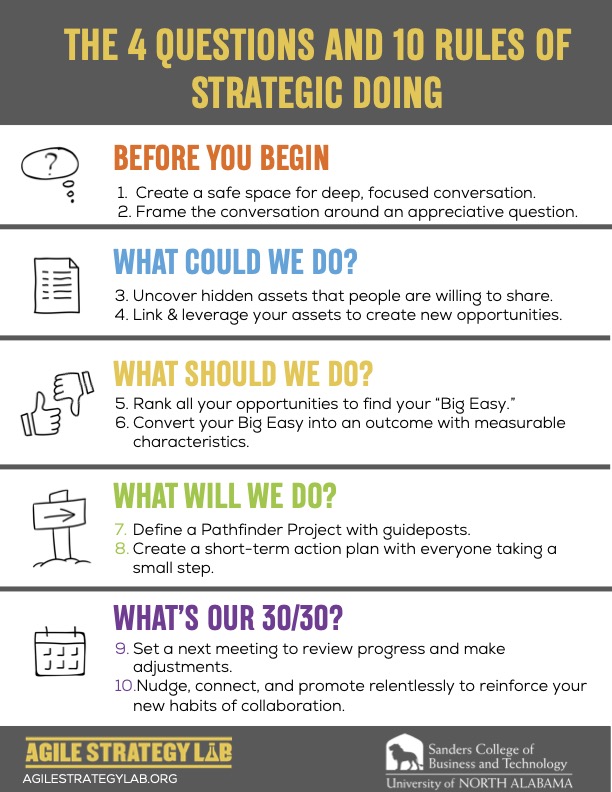4 Questions and 10 Rules of Strategic Doing

The Quick Guide
Welcome to Agile Strategy Lab's focused guide on the "4 Questions and 10 Rules of Strategic Doing." This resource is specifically tailored for organizations and teams keen on implementing a dynamic, collaborative approach to strategy formulation and execution.
Before you Begin
1. Create a safe space for deep, focused conversations.
2. Frame the conversation around an appreciate question.
What could we do?
3. Uncover hidden assets that people are willing to share.
4. Link & Leverage your assets to create new opportunities.
What should we do?
5. Rank all your opportunities to find your "Big Easy"
6. Convert your Big Easy into an outcome with measurable characteristics.
What will we do?
7. Define a Pathfinder Project with guideposts
8. Create a short-term action plan with everyone taking a small step.
What's our 30/30?
9. Set a next meeting to review progress and make adjustments.
10. Nudge, connect, and promote relentlessly to reinforce your new habits of collaboration.
Example: 4 Questions and 10 Rules of Strategic Doing
Sample
Here, we’ll explore how a specific group — let's say the marketing team at EcoFriendly Inc., a company specializing in sustainable products — can apply these questions and rules to enhance their strategic initiatives.
Before You Begin
- Create a Safe Space for Deep, Focused Conversations
EcoFriendly Inc.’s marketing team has been stuck with the same limited approach to for the last year. One of their employees trained in Strategic Doing suggests a scheduled meeting in a relaxed setting. The session is designed to encourage open dialogue, where each member feels comfortable to express innovative ideas without fear of criticism. - Frame the Conversation Around an Appreciative Question
The team starts their strategic session with the question, “How can we leverage our unique strengths in sustainability to enhance our market presence?”
What Could We Do?
- Uncover Hidden Assets That People Are Willing to Share
During a brainstorming session, a team member mentions her close contacts with influential eco-bloggers, a connection the team hadn’t utilized before. - Link & Leverage Your Assets to Create New Opportunities
Recognizing the value of these blogger contacts, the team plans a collaborative campaign with these influencers to promote EcoFriendly's new product line.
What Should We Do?
- Rank All Your Opportunities to Find Your 'Big Easy'
The marketing team evaluates various strategies like social media campaigns, influencer collaborations, and green events. They identify the influencer campaign as their 'Big Easy' – high impact with feasible resource requirements. - Convert Your Big Easy into an Outcome with Measurable Characteristics
The 'Big Easy' influencer campaign is structured with clear goals: a 30% increase in social media engagement and a 15% rise in online sales within the next quarter.
What Will We Do?
- Define a Pathfinder Project with GuidepostsExample: The team decides on a pilot influencer campaign focusing on a select group of eco-bloggers to promote a specific product, setting clear milestones for engagement and sales uplift.
- Create a Short-Term Action Plan with Everyone Taking a Small StepExample: Each team member is assigned a specific role for the campaign, from content creation to coordination with influencers, ensuring collective responsibility and action.
What's Our 30/30?
- Set a Next Meeting to Review Progress and Make Adjustments
EcoFriendly’s marketing team schedules a follow-up meeting 30 days post-campaign launch to review the effectiveness and discuss necessary adjustments based on the initial outcomes. - Nudge, Connect, and Promote Relentlessly to Reinforce Your New Habits of Collaboration
The team leader continuously encourages cross-department collaboration, sharing progress updates, and celebrating small wins to maintain momentum and team spirit.
Conclusion
Through the lens of EcoFriendly Inc.'s marketing team, we see how Strategic Doing can transform a standard strategic approach into a more dynamic, collaborative, and effective process. By addressing the four critical questions and adhering to the ten guiding rules, teams can create a more agile, responsive, and innovative strategic environment. Use these principles as your roadmap, and embark on a journey of strategic transformation.
